R-4: Difference between revisions
Pbcjohnston (talk | contribs) (Updated formatting) |
Pbcjohnston (talk | contribs) (Added late 1930s picture) |
||
| (3 intermediate revisions by 2 users not shown) | |||
| Line 1: | Line 1: | ||
[[File:R-Boat Header 1.jpg]] | [[File:R-Boat Header 1.jpg]] | ||
[[File:R-4 underway.jpg|left|500px]] | |||
<div style="text-align: justify;"><span style="color:#00008B">A dramatic photo of the R-4. The submarine is traveling at full speed and the propellers are tossing up an impressive spray heading to sea. On the horizon to the left is a gaff rigged sloop or cutter giving some depth of field to the camera. | |||
There are a number of crew on the main deck at the aft end of the bridge fairwater, several more on the fairwater next to the periscope shears, blocking the submarine's name, and several on the bridge itself. All are wearing light clothing. The hatch is open to allow air to the diesels and probably allow some ventilation of fumes from the submarine. | |||
This is a mid 1919 to early 1920 photo since the submarine's deck gun has not yet been installed, although the mine cable anti-fouling structure surrounding the SC and J-tube listening heads on deck is in place. By mid 1920 these frames have been removed from all the R-class boats. | |||
<small>Image from an original glass plate negative in the private collection of Ric Hedman.</small> | |||
[[File:Red bar sub new.jpg]] | |||
[[File:R-4 on a river.jpg|left|500px]] | |||
<div style="text-align: justify;"><span style="color:#00008B">A very nice but unfortunately unfocused photo of R-4 underway in a river or past a coastline, most likely taken in the summer or early fall of 1919. The R-4 was placed in commission on March 28, 1919 with Lt. Palmer Hall Dunbar, Jr. in command. In this photo she has not yet had her 3"/50 caliber deck gun installed, a good point of reference to get dating on a photo. A possible date could be in September 1919, which would go along with the tree foliage when the R-4 and the R-22 were on recruiting drives along the New England coast. She and the R-22 were reported to have left Bridgeport, CT. on September 11, 1919, bound for New London. | |||
The large hotel or resort on the cliff ought to give some indication of location but it is yet to be found. Anyone recognizing this location please contact us. | |||
<small>From an original negative in the private collection of Ric Hedman.</small> | |||
[[File:Red bar sub new.jpg]] | |||
[[File:R-4 dry dock.jpg|left|500px]] | [[File:R-4 dry dock.jpg|left|500px]] | ||
<div style="text-align: justify;"><span style="color:#00008B">A Navy photo of the R-4 in drydock undergoing overhaul. The date is late 1920 and the location is the Norfolk Navy Yard in Portsmouth, VA. The unusual pipe structure on the bow that was to protect the sonar listening devices installed on the foredeck. The tube at the tip of the bow is a towing fairlead, sometimes called a "bullnose". A towing chain has been passed through it and secured alongide the deck on the port side. Note also the angular, slab-sided covers for the bow plane pivot mechanism. The bow planes themselves are partially rigged out, likely for maintenance. The R-class were the last of the EB design submarines to have the bow planes fold up alongside the superstructure. In the following S-class submarines the bow planes retracted inside the superstructure. | |||
<small>U.S. Navy photo.</small> | |||
[[File:Red bar sub new.jpg]] | |||
[[File:R-4 docked.jpg|left|500px]] | [[File:R-4 docked.jpg|left|500px]] | ||
[[File:R-4 | <div style="text-align: justify;"><span style="color:#00008B">A press photo taken of the R-4 at what looks to be San Pedro (Los Angeles), CA. circa 1922 while she was attached to the submarine squadron there from June 30, 1921 to April 10, 1923 | ||
[[File:R-4 underway.jpg|left|500px]] | |||
This photo was used by the newspapers for the story about the R-4 finding a seaplane trying to make a non-stop flight from San Francisco to Hawaii. The plane ran out of gas and was adrift for nine days before rescue by the R-4. The newspaper had heavily edited the negative (specifically the port side of the R-4) to make detail stand out during the printing process. | |||
It looks like there is some bedding being aired draped over the deck gun. One man looks to be adjusting a mooring line and what appears to be an officer is standing just behind the man on the right. | |||
<small>Photo in the private collection of Ric Hedman.</small> | |||
[[File:Red bar sub new.jpg]] | |||
[[File:R-4 1935.jpg|left|500px]] | |||
<div style="text-align: justify;"><span style="color:#00008B">R-4 is shown here at the Electric Boat Company piers in Groton, CT., during the launch of the USS [[174|'''Shark (SS-174)''']] on May 21, 1935. By the date of this photo, the Navy was repainting all of its submarines in a standard flat black paint scheme. It was a lengthy process to get all of the boats repainted, taking more than a year. It is interesting to note that R-4 has yet to be repainted and is still wearing her original haze gray paint scheme. | |||
<small>Photo in the private collection of Ric Hedman.</small> | |||
[[File:Red bar sub new.jpg]] | |||
[[File:R-4 1935 A.jpg|left|500px]] | |||
<div style="text-align: justify;"><span style="color:#00008B">In this closeup of the photo above, the conning tower fairwater of the newly launched USS Shark (SS-174) can be seen just to the left of R-4's fairwater. Shark was sporting the P-3 [https://pigboats.icci.llc/images/b/b2/Submarine_names_2.pdf '''class identifier'''] on her fairwater at this time. | |||
<small>Photo in the private collection of Ric Hedman.</small> | |||
[[File:Red bar sub new.jpg]] | |||
[[File:R-4 late 1930s Groton.jpg|left|500px]] | |||
R-4 is shown alongside at Submarine Base New London, Groton, CT. The date is not known for sure, but based on the black paint job and her name on the fairwater opposed to her hull number this photo was taken between late 1935 and 1939. During this period she was serving as a training ship for the Submarine School and the NROTC unit at Yale University in nearby New Haven, CT. | |||
<small>Photo in the private collection of Ric Hedman.</small> | |||
[[File:Red bar sub new.jpg]] | |||
[[File:R-4 hurricane 1938 A.jpg|left|500px]] | |||
<div style="text-align: justify;"><span style="color:#00008B">This dramatic photo shows R-4 (right) and an unidentified R-class boat tied to the piers at Submarine Base New London, Groton, CT. on September 21, 1938 during an unnamed hurricane. | |||
The 1938 hurricane sent so much water up the Thames River that the pier these two boats were moored to was submerged by the tide. You can see the mooring lines from the boats to the dock going into the water. | |||
The hurricane made landfall in Suffolk County on Long Island, New York on September 21, 1938 as a strong Category 3 hurricane on the present-day Saffir-Simpson Hurricane Scale with a central pressure of 946 mbar (hPa).It then traveled across Long Island Sound into Connecticut, Rhode Island, Massachusetts, New Hampshire, Vermont, and finally into Canada while still moving at an unusually high speed. | |||
The hurricane hit Long Island around 3:30 p.m., which was just a few hours before astronomical high tide. At this time the eye was about 50 miles across and the hurricane was about 500 miles wide. | |||
New London was first swept by the winds and storm surge; then the waterfront business district caught fire and burned out of control for 10 hours. Stately homes along Ocean Beach were leveled by the storm surge. The permanently anchored 240-ton lightship at the head of New London Harbor was found on a sand bar two miles away. | |||
<small>Photo in the private collection of Ric Hedman.</small> | |||
[[File:Red bar sub new.jpg]] | |||
[[File:R-4 hurricane 1938 B.jpg|left|500px]] | |||
<div style="text-align: justify;"><span style="color:#00008B">Another view of the R-4 during the 1938 hurricane. There is a sailor on the far right keeping an eye on the boats at the pier. Note the semi-submerged pier crane in the background. As far as can be determined the submarines were not seriously damaged by the storm. Typically, procedure would have been to get the boats underway and ride out the storm at sea. Why this was not done on this occasion is not known. | |||
<small>Photo in the private collection of Ric Hedman.</small> | |||
[[File:Red bar sub new.jpg]] | |||
[[File:R-4 drydock Key West 1941 A.jpg|left|500px]] | |||
<div style="text-align: justify;"><span style="color:#00008B">R-4 entering the floating drydock at Naval Station Key West, Florida circa July 1941. At this point the boat is firmly on the keel blocks and the dock ballast tanks are being pumped out to raise the dock and the submarine clear of the water. The R-4 was stationed at Key West for the duration of WWII working with the Sonar School and making patrols in the Florida Straits and the Yucatan Channel. | |||
<small>U.S. Navy photo.</small> | |||
[[File:Red bar sub new.jpg]] | |||
[[File:R-4 drydock Key West 1941 B.jpg|left|500px]] | |||
<div style="text-align: justify;"><span style="color:#00008B">R-4 in drydock at Key West circa July 1941. The hull has undergone scraping and she now has primer paint covering her bare metal. Her anchor has been removed, maybe for scraping and painting. Note that by this date the hull number is the only external visual identification. This was in keeping with the standard set forth by the Navy in 1939. | |||
<small>U.S. Navy photo.</small> | |||
[[File:Red bar sub new.jpg]] | |||
[[File:R-4 drydock Key West 1941 C.jpg|left|500px]] | |||
<div style="text-align: justify;"><span style="color:#00008B">A view of R-4 from the bottom of the drydock during the 1941 Key West overhaul. The hull has undergone scraping and she now has primer paint covering her bare metal. Her bottom mounted mushroom anchor can be seen behind the first set of keel blocks. The oval is where the MV series sonar would have been mounted, but it appears to have been removed. The circular Fessenden Oscillator transducer is seen just above the officer or Chief's head. | |||
<small>U.S. Navy photo.</small> | |||
[[File:Red bar sub new.jpg]] | |||
<div style="text-align: justify;"><span style="color:#00008B"> | [[File:R-4 crew 1943.jpg|left|500px]] | ||
<div style="text-align: justify;"><span style="color:#00008B">R-4 crew photo from May of 1943 when she was stationed at Key West. The commanding officer, Lt. Philip W. Garnett, is one of the two officers in the center of the front row. MoMM 2nd Class Andrew Stalma was a crewmember on R-4 at this time, but is not shown in this photo. | |||
<small>Photo | <small>Photo submitted by Ron Stalma, whose father Andrew Stalma MoMM 2/c served aboard the R-4 during WW II.</small> | ||
[[File:Red bar sub new.jpg]] | [[File:Red bar sub new.jpg]] | ||
Latest revision as of 19:14, 25 April 2024
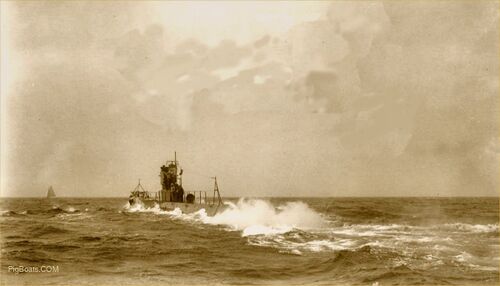
There are a number of crew on the main deck at the aft end of the bridge fairwater, several more on the fairwater next to the periscope shears, blocking the submarine's name, and several on the bridge itself. All are wearing light clothing. The hatch is open to allow air to the diesels and probably allow some ventilation of fumes from the submarine.
This is a mid 1919 to early 1920 photo since the submarine's deck gun has not yet been installed, although the mine cable anti-fouling structure surrounding the SC and J-tube listening heads on deck is in place. By mid 1920 these frames have been removed from all the R-class boats.
Image from an original glass plate negative in the private collection of Ric Hedman.
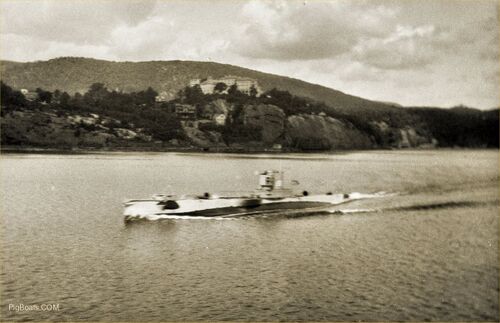
The large hotel or resort on the cliff ought to give some indication of location but it is yet to be found. Anyone recognizing this location please contact us.
From an original negative in the private collection of Ric Hedman.
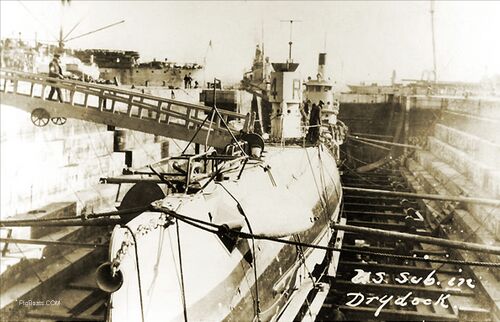
U.S. Navy photo.
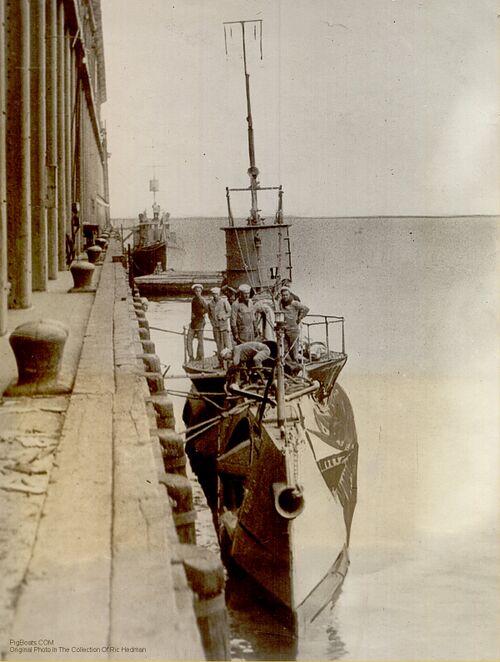
This photo was used by the newspapers for the story about the R-4 finding a seaplane trying to make a non-stop flight from San Francisco to Hawaii. The plane ran out of gas and was adrift for nine days before rescue by the R-4. The newspaper had heavily edited the negative (specifically the port side of the R-4) to make detail stand out during the printing process.
It looks like there is some bedding being aired draped over the deck gun. One man looks to be adjusting a mooring line and what appears to be an officer is standing just behind the man on the right.
Photo in the private collection of Ric Hedman.
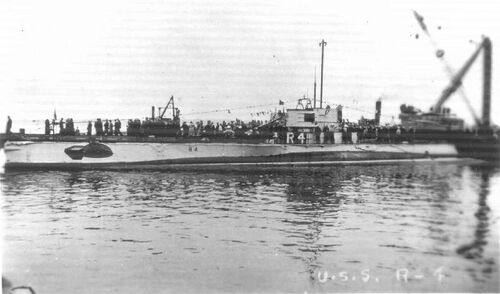
Photo in the private collection of Ric Hedman.
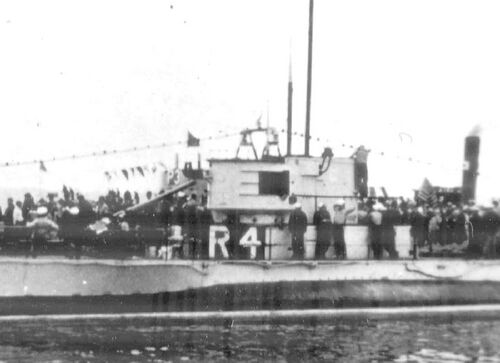
Photo in the private collection of Ric Hedman.
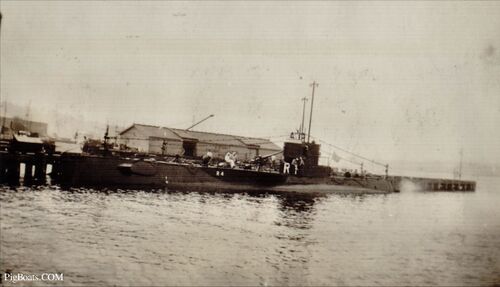
R-4 is shown alongside at Submarine Base New London, Groton, CT. The date is not known for sure, but based on the black paint job and her name on the fairwater opposed to her hull number this photo was taken between late 1935 and 1939. During this period she was serving as a training ship for the Submarine School and the NROTC unit at Yale University in nearby New Haven, CT.
Photo in the private collection of Ric Hedman.
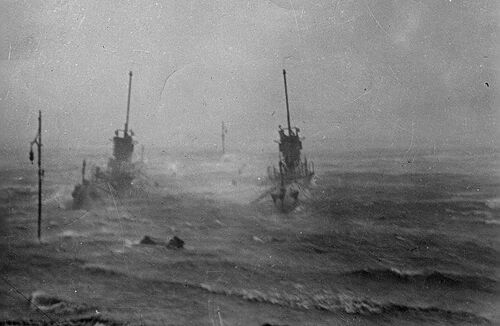
The 1938 hurricane sent so much water up the Thames River that the pier these two boats were moored to was submerged by the tide. You can see the mooring lines from the boats to the dock going into the water.
The hurricane made landfall in Suffolk County on Long Island, New York on September 21, 1938 as a strong Category 3 hurricane on the present-day Saffir-Simpson Hurricane Scale with a central pressure of 946 mbar (hPa).It then traveled across Long Island Sound into Connecticut, Rhode Island, Massachusetts, New Hampshire, Vermont, and finally into Canada while still moving at an unusually high speed.
The hurricane hit Long Island around 3:30 p.m., which was just a few hours before astronomical high tide. At this time the eye was about 50 miles across and the hurricane was about 500 miles wide.
New London was first swept by the winds and storm surge; then the waterfront business district caught fire and burned out of control for 10 hours. Stately homes along Ocean Beach were leveled by the storm surge. The permanently anchored 240-ton lightship at the head of New London Harbor was found on a sand bar two miles away.
Photo in the private collection of Ric Hedman.
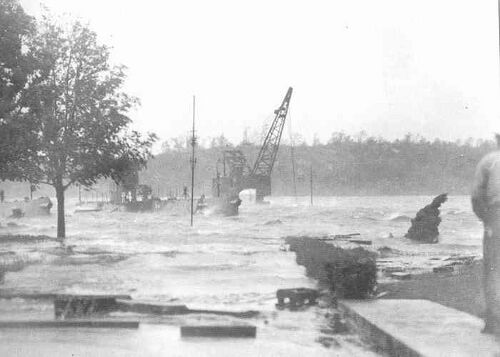
Photo in the private collection of Ric Hedman.
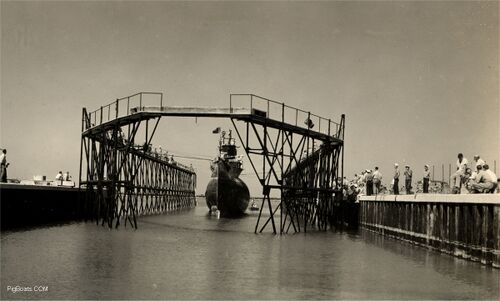
U.S. Navy photo.
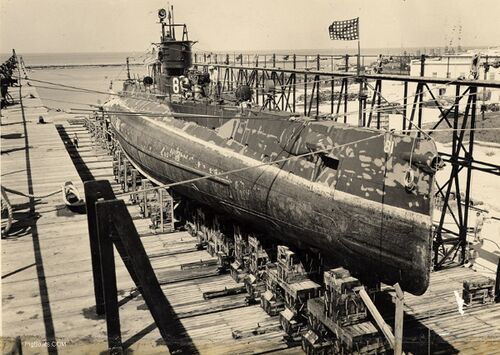
U.S. Navy photo.

U.S. Navy photo.

Photo submitted by Ron Stalma, whose father Andrew Stalma MoMM 2/c served aboard the R-4 during WW II.
Page created by:
Ric Hedman & David Johnston
1999 - 2023 - PigBoats.COM©
Mountlake Terrace, WA, Norfolk, VA
webmaster at pigboats dot com
